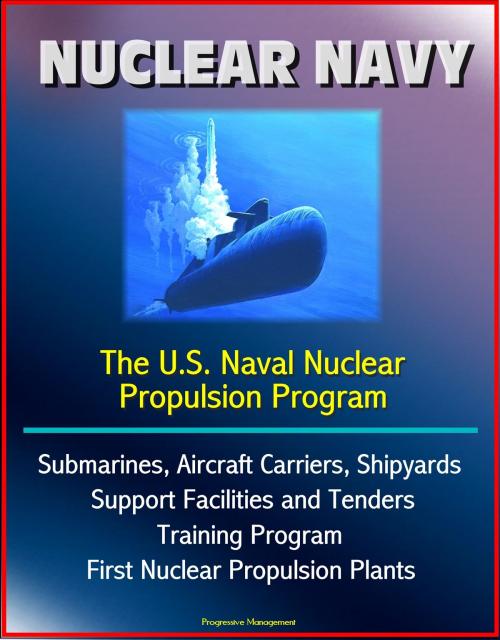Nuclear Navy: The U.S. Naval Nuclear Propulsion Program - Submarines, Aircraft Carriers, Shipyards, Support Facilities and Tenders, Training Program, History of First Nuclear Propulsion Plants
Nonfiction, History, Military, Naval| Author: | Progressive Management | ISBN: | 9781301303274 |
| Publisher: | Progressive Management | Publication: | March 31, 2013 |
| Imprint: | Smashwords Edition | Language: | English |
| Author: | Progressive Management |
| ISBN: | 9781301303274 |
| Publisher: | Progressive Management |
| Publication: | March 31, 2013 |
| Imprint: | Smashwords Edition |
| Language: | English |
This is a comprehensive, up-to-date survey of the U.S. Navy's nuclear propulsion program. Navy warships are deployed around the world every hour of every day to provide a credible "forward presence," ready to respond on the scene wherever America's interests are threatened. Nuclear propulsion plays an essential role in this, providing the mobility, flexibility, and endurance that today's smaller Navy requires to meet a growing number of missions. About 45 percent of the Navy's major combatants are nuclear-powered: 11 aircraft carriers, 53 attack submarines, and 18 strategic submarines (the Nation's most survivable deterrent) — 4 of which were removed from strategic service and converted to a covert, high-volume, precision strike platform designated as SSGN.
The mission of the Naval Nuclear Propulsion Program, also known as Naval Reactors, is to provide militarily effective nuclear propulsion plants and ensure their safe, reliable, and long-lived operation. This mission requires the combination of fully trained U.S. Navy men and women with ships that excel in endurance, stealth, speed, and independence from logistics supply chains. Presidential Executive Order 12344 and Public Laws 98-525 and 106-65 set forth the total responsibility of Naval Reactors for all aspects of the Navy's nuclear propulsion, including research, design, construction, testing, operation, maintenance, and ultimate disposition of naval nuclear propulsion plants. The Program's responsibility includes all related facilities, radiological controls, environmental safety, and health matters, as well as selection, training, and assignment of personnel. All of this work is accomplished by a lean network of dedicated research laboratories, nuclear-capable shipyards, equipment contractors and suppliers, and training facilities that are centrally controlled by a small headquarters staff. The Director, Naval Reactors, is Admiral Kirkland H. Donald; who also serves as a Deputy Administrator in the National Nuclear Security Administration.
Contents: Naval Nuclear Propulsion Program * Advantages of Naval Nuclear Power * Today's Mission * Nuclear-Powered Submarines * Nuclear-Powered Aircraft Carriers * What is the Naval Nuclear Propulsion Program? * Research, Development, and Support Laboratories * Nuclear Component Procurement Organization * Nuclear Equipment Suppliers * Shipyards * Support Facilities and Tenders * Schools and Training Facilities * Headquarters * Establishment of the Program . * Technical and Management Philosophy * The Training Program. * What it Means to be a Sailor in the Naval Nuclear Propulsion Program * Description of a Typical Naval Nuclear Propulsion Plant * Protection of People * Concern for the Environment * Naval Nuclear Propulsion Program Emergency Preparedness * Naval Spent Nuclear Fuel Transportation Exercises * Partnership with State and Local Officials * Naval Nuclear Propulsion Program Accomplishments * Appendix * The First Naval Nuclear Propulsion Plants * Classes of Nuclear-Powered Ships. * Operations * Special Projects * Program Locations * Program Directors — Past and Present * Program Statistics
This is a comprehensive, up-to-date survey of the U.S. Navy's nuclear propulsion program. Navy warships are deployed around the world every hour of every day to provide a credible "forward presence," ready to respond on the scene wherever America's interests are threatened. Nuclear propulsion plays an essential role in this, providing the mobility, flexibility, and endurance that today's smaller Navy requires to meet a growing number of missions. About 45 percent of the Navy's major combatants are nuclear-powered: 11 aircraft carriers, 53 attack submarines, and 18 strategic submarines (the Nation's most survivable deterrent) — 4 of which were removed from strategic service and converted to a covert, high-volume, precision strike platform designated as SSGN.
The mission of the Naval Nuclear Propulsion Program, also known as Naval Reactors, is to provide militarily effective nuclear propulsion plants and ensure their safe, reliable, and long-lived operation. This mission requires the combination of fully trained U.S. Navy men and women with ships that excel in endurance, stealth, speed, and independence from logistics supply chains. Presidential Executive Order 12344 and Public Laws 98-525 and 106-65 set forth the total responsibility of Naval Reactors for all aspects of the Navy's nuclear propulsion, including research, design, construction, testing, operation, maintenance, and ultimate disposition of naval nuclear propulsion plants. The Program's responsibility includes all related facilities, radiological controls, environmental safety, and health matters, as well as selection, training, and assignment of personnel. All of this work is accomplished by a lean network of dedicated research laboratories, nuclear-capable shipyards, equipment contractors and suppliers, and training facilities that are centrally controlled by a small headquarters staff. The Director, Naval Reactors, is Admiral Kirkland H. Donald; who also serves as a Deputy Administrator in the National Nuclear Security Administration.
Contents: Naval Nuclear Propulsion Program * Advantages of Naval Nuclear Power * Today's Mission * Nuclear-Powered Submarines * Nuclear-Powered Aircraft Carriers * What is the Naval Nuclear Propulsion Program? * Research, Development, and Support Laboratories * Nuclear Component Procurement Organization * Nuclear Equipment Suppliers * Shipyards * Support Facilities and Tenders * Schools and Training Facilities * Headquarters * Establishment of the Program . * Technical and Management Philosophy * The Training Program. * What it Means to be a Sailor in the Naval Nuclear Propulsion Program * Description of a Typical Naval Nuclear Propulsion Plant * Protection of People * Concern for the Environment * Naval Nuclear Propulsion Program Emergency Preparedness * Naval Spent Nuclear Fuel Transportation Exercises * Partnership with State and Local Officials * Naval Nuclear Propulsion Program Accomplishments * Appendix * The First Naval Nuclear Propulsion Plants * Classes of Nuclear-Powered Ships. * Operations * Special Projects * Program Locations * Program Directors — Past and Present * Program Statistics















